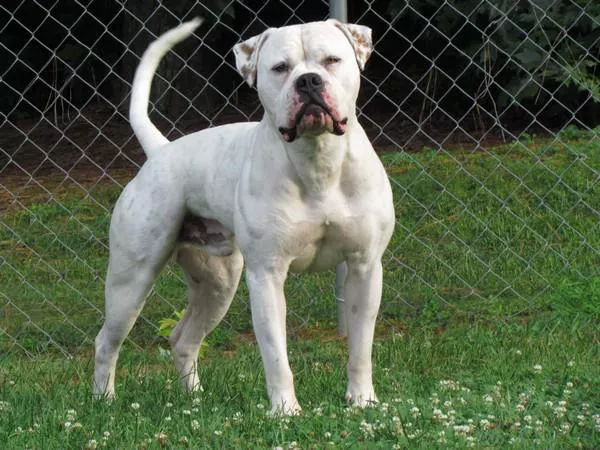American Bulldogs are a unique breed known for their strength and loyalty. To keep your American Bulldog healthy and thriving, their diet is a critical factor. In this American Bulldog feeding guide, we’ll explore five essential things you need to know to provide the best nutrition for your four-legged friend.
1. Choose High-Quality Dog Food:
Selecting the right dog food is the foundation of your American Bulldog‘s health. Look for high-quality dog food brands that prioritize real, meat-based ingredients. The first ingredient should be a quality protein source, such as chicken, beef, or fish. Avoid dog foods with fillers like corn, soy, or wheat, as these can be hard on your Bulldog’s digestion.
Consider dog food formulated for large breeds, as American Bulldogs fall into this category. These formulas often contain the appropriate balance of nutrients to support their size and activity level.
2. Age-Appropriate Nutrition:
Your American Bulldog’s nutritional needs change with age. Puppies require a diet that promotes growth and development, typically featuring higher protein and calorie levels. Adult Bulldogs need maintenance-level nutrition, while senior dogs benefit from foods designed to address aging-related concerns.
Choose dog food that matches your Bulldog’s life stage to ensure they get the right nutrients at the right time.
3. Protein Matters:
Protein is essential for your American Bulldog’s muscle development and overall health. Aim for dog foods with a protein content of around 20-30%. High-quality animal proteins like chicken, turkey, or salmon are easily digestible and provide essential amino acids.
Protein from animal sources is more beneficial than plant-based proteins. Look for specific meat sources on the ingredient list, such as “chicken meal” or “beef meal.”
4. Monitor Fat Content:
While protein is important, you must also consider fat content. Bulldogs are prone to obesity, which can lead to various health issues. Opt for dog food with moderate fat levels, typically around 10-15%, to help maintain a healthy weight.
If your Bulldog is overweight or has specific dietary requirements, consult with your veterinarian for guidance on low-fat dog food options.
5. Portion Control and Hydration:
Proper portion control is crucial to prevent overfeeding and maintain a healthy weight for your American Bulldog. Follow the recommended feeding guidelines on the dog food packaging based on your dog’s age, weight, and activity level.
Additionally, ensure your Bulldog has access to clean, fresh water at all times. Adequate hydration is vital for digestion and overall well-being.
In conclusion, providing the best nutrition for your American Bulldog involves selecting high-quality dog food, considering their age-specific needs, focusing on protein-rich options, monitoring fat intake, and practicing portion control while maintaining proper hydration. Always consult with your veterinarian for personalized dietary recommendations and guidance on maintaining your Bulldog’s health and happiness.
FAQs related to American Bulldog feeding and nutrition:
Q1: How much should I feed my American Bulldog each day?
A1: The amount of food your American Bulldog needs depends on factors like their age, weight, activity level, and the specific dog food you’re using. Refer to the feeding guidelines provided on the dog food packaging as a starting point. However, it’s essential to consult with your veterinarian for personalized recommendations based on your dog’s individual needs.
Q2: Are there any specific dietary requirements for American Bulldog puppies?
A2: Yes, American Bulldog puppies require a diet that supports their growth and development. Look for puppy-specific dog food with higher protein and calorie levels. Consult your vet for guidance on feeding frequency and portion sizes for your Bulldog puppy.
Q3: Can I feed my American Bulldog a homemade or raw diet?
A3: Yes, some owners choose to feed their American Bulldogs homemade or raw diets. However, this approach requires careful planning and consultation with a canine nutritionist or veterinarian to ensure your dog receives all the necessary nutrients. Raw diets often include meat, bones, organs, and vegetables.
Q4: How can I tell if my American Bulldog is overweight, and what should I do about it?
A4: You can assess your Bulldog’s weight by looking for visible signs such as a well-defined waist and being able to feel their ribs without excess fat covering. If you suspect your Bulldog is overweight, consult your vet for a weight management plan. This may involve adjusting their diet, portion sizes, and increasing their exercise.
Q5: What should I do if my American Bulldog has food allergies or sensitivities?
A5: If your Bulldog has food allergies or sensitivities, work closely with your veterinarian to identify the specific allergens. Your vet may recommend hypoallergenic dog food or a limited-ingredient diet. Avoid feeding your dog anything that triggers allergic reactions.
Q6: Can American Bulldogs eat fruits and vegetables?
A6: Yes, many American Bulldogs enjoy fruits and vegetables as treats or additions to their diet. Safe options include carrots, apples, blueberries, and sweet potatoes. However, always consult with your vet before introducing new foods to your dog’s diet, as some may be sensitive to certain fruits and vegetables.
Q7: How often should I feed my American Bulldog?
A7: Most adult American Bulldogs are typically fed twice a day. Puppies may require more frequent meals, up to four times a day, to meet their growing needs. Consult your vet for a feeding schedule that suits your dog’s age and activity level.
Q8: Are there any foods that are toxic to American Bulldogs?
A8: Yes, there are several foods that are toxic to dogs, including American Bulldogs. Some common examples include chocolate, grapes, raisins, onions, garlic, and certain artificial sweeteners like xylitol. Avoid feeding your Bulldog these harmful substances, and keep them out of reach.


